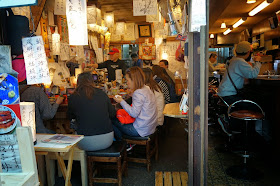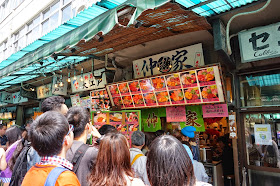 |
| It was a day for Tokyo and nothing like a good weather in the morning. We were all set to start it and it was south bound from Oak Hotel. |
 |
| Interesting breakfast with rice, soup and fried eggs |
 |
| One of the many economical food joints found in the city. |
 |
| As we approaches the Imperial Palace we were greeted with colourful flowering trees. It's cherry blossom in Tokyo. |
We took a round at the periphery roads to see the surroundings of the palace.
 |
| At the statue outside the Imperial Palace. Kusunoki Masashige (楠木 正成, 1294 – July 4, 1336) was a 14th-century samurai who fought for Emperor Go-Daigo in his attempt to wrest rulership of Japan away from the Kamakura shogunate and is remembered as the ideal of samurai loyalty. His origin has not been validated and it was merely six years between the start of his military campaign in 1331 and his demise in 1336. He received the highest decoration from the Meiji government of Japan in 1880. |
 |
| At the pedestrian road crossing of Ginza. |
 |
| A tea break before proceeding with our rides. |
 |
| Summons by the Police for illegal bike parking in the city is a common scene. |
 |
| We have reached our very much desired destination a fish market called Tsukiji after nearly 9 km of roaming in the city of Tokyo. |
 |
| The Tsukiji Market (築地市場), supervised by the Tokyo Metropolitan Central Wholesale Market(東京都中央卸売市場) of the Tokyo Metropolitan Bureau of Industrial and Labor Affairs, is the biggest wholesale fish and seafood market in the world and also one of the largest wholesale food markets of any kind. |
 |
| The market is located in Tsukiji in central Tokyo, between the Sumida River and the upmarket Ginza shopping district. While the inner wholesale market has restricted access to visitors, the outer retail market, restaurants and associated restaurant supply stores remain a major tourist attraction for both domestic and overseas visitors. |
There are plenty of sushi counters here, but to find the best ones, you need to wend your way to the restaurant area near the wholesale fruit and vegetable market, just inside the main gate off Shin-ohashi Street. To me the food is the same at any corners of this market.
 |
| Our brommies were simply parked together with other bicycles at this road side. |
 |
| It's been said that no visit to Tsukiji is complete without a sushi breakfast. It was because of this sentence Jo queued for it. |
 |
| Actually we gave up after a while of queuing and decided to forget about eating at the fish market but as we were leaving the place we saw more places offering food and found this one which do not need to wait too long and this was the shop we patronised. |
 |
| Ryo Sushi one of the many shops serving good sushi. Let's try. |
 |
| Our main man who served our meals on that day. |
The sushi freshly prepared and served on the slim black marble slab at the eating counter.
 |
| Our shared Ryu Sushi for 2,500 yen. |
 |
| Jo opted for this eel delicacy with glutinous rice. |
 |
| There were more places for eating, these people were eating at the road pavement next to the road... and more as you walk down the street. |
 |
| The"outer market" (jōgai-shijō) is a mixture of wholesale and retail shops that sell Japanese kitchen tools, restaurant supplies, groceries, and seafood, and many restaurants, especially sushi restaurants. |
 |
| The Tsukiji fish market occupies valuable real estate close to the center of the city. Former Tokyo Governor Shintaro Ishihara repeatedly called for moving the market to Toyosu,Koto. The long-anticipated move to the new market will take place in November 2016, in preparation for the 2020 Tokyo Summer Olympics. The new location has been criticized for being heavily polluted and in need of cleanup. There are plans to retain a retail market, roughly a quarter of the current operation, in Tsukiji. The remaining area of the market will be redeveloped. |
 |
| After the famous fish market I decided to pay a visit to Loro Tokyo. |
 |
| I got myself a replace bag cover for my S bag. |
 |
| The exploration continued at times using bridges of such nature which are bicycle friendly. |
 |
| Akihabara gained the nickname Akihabara Electric Town (秋葉原電気街) shortly after World War II for being a major shopping center for household electronic goods and the post-war black market. |
 |
| Nowadays, Akihabara is considered by many to be an otaku cultural center and a shopping district for video games, anime, manga, and computer goods. Icons from popular anime and manga are displayed prominently on the shops in the area, and numerous maid cafés are found throughout the district. |
 |
| Ameyoko (アメ横) is a busy market street along the Yamanote Line tracks between Okachimachi and Ueno Stations. The name "Ameyoko" is a short form for "Ameya Yokocho" (candy store alley), as candies were traditionally sold there. Alternatively, "Ame" also stands for "America", because a lot of American products used to be available there when the street was the site of a black market in the years following World War Two. |
 |
| By now we were closing to our base at Ueno as the sun set and a drink or two would be lovely. |
These delicious yakitori with some dashes of spicy pepper were heavenly good.
 |
| What a wonderful way to end the day's exploration at a busy street, sipping my beer and watching the people moving up and down. |





































I am enjoying the post as I read..thanks for sharing such a wonderful day trip.
ReplyDelete